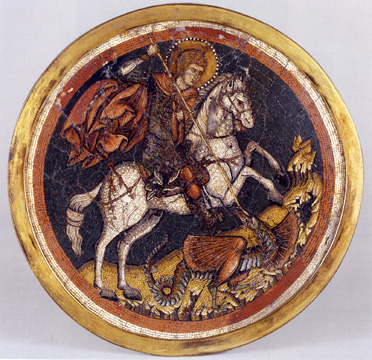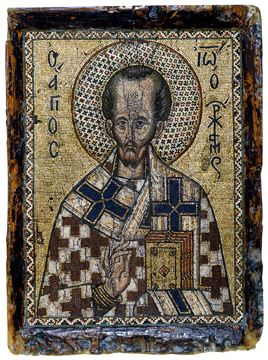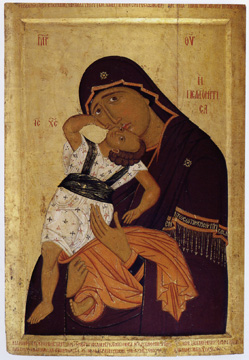Introduction
By Byzantine Art is meant the art that was produced by the Eastern Roman Empire or the Byzantine Empire that continued from the 5th Century till 1453 when Constantinople fell. Byzantine Art also refers to the art of the states that came under its aegis, sharing a common legacy – Bulgaria, Serbia and or Russia. Venice too can be included as it had intimate links with the Byzantine Empire. It also refers to the art produced after the decay of Constantinople in the hands of the Ottoman Empire. “So in a very broad sense it includes the art of Russia, Greece and other countries under the Greek Orthodox Church” (James 692-692). In this context, the role of portraiture, including the saints, in Byzantine art became a very significant form of art.
Background

Byzantine art had its roots in Ancient Greece and never broke ties with this classical link. But there were differences. “The focus on humanistic ethics of Greek art was replaced by Christian philosophy” (Simson 132). Classical art glorified man but Byzantine art glorified God and the Son of God – Jesus Christ. This led to disappearing of nude figures in Byzantine tradition. “The figures that dominated were that of God the Father, Jesus and the Virgin Mary” (Simson 132). The saints and the martyrs also crowded in. And they became the main and sole focus of Byzantine Art. Thus the icon came to dominate Byzantine Art. Icon generates reverential worship and it is the link between God and man. “Icon is the rendering of prayers, hymns and sermons in the form and in color” (Simson 132).
The “portraiture of’Saint George Slaying the Dragon (14th Century) or Saint John Chrysostom (1325) evokes the sense of the supremacy related to Christianity. Where as, Makariya Zograf’s ‘Holy Virgin Pelagonitissa’ (1421)” (Nelson 489-502) reveals the underlying love and humbleness of the religion.

Discussion
The Byzantine artists lost interest in Nature and portraits that were real. “Only the ideal images of Jesus and the saints were used” (Simson 142). This became the norm. The artist brought out the inner thoughts pinpointing it on the icons. It was a deviation from the multiple pagan arts that was more sensual in the classical age. Thought took precedence over reality.
Analysis

The Byzantine artists developed new technical skills ascending artistic heights. This was reflected in the works of goldsmiths and silversmiths, enamel workers, jewelers and makers and textile weavers. Keeping touch with the classical age they stamped their own ingenuity in their art. It was the same in architecture – the living symbol of which is the building of Hagia Sophia (Simson 132).
The art of portraiture in Byzantine Art is known as iconography. It is ritualistic art and holy. It is more spiritual than just about ornamentation and decoration. In Greek it is called hagiography or the picture that is holy. It depicts the individuals and the sacred ideas. As such the monks were the sole keepers of this art and the work was done inside the church from beginning to end. The portrait in Byzantine Art had a spiritual meaning that goes above the mundane world. It is not just about mechanical skill but something beyond. Thus the materials used were natural, pure and fragrant. For the drawing of the portraits aromatic wood from the cypress, chestnut or pine was taken (Beckwith 65). Color was obtained the earth. After mixing with water earth gives out a divine fragrance that has not been lost in time.
Result
Rough or thick stuff was not used in Byzantine Art such as is used in other forms of art – flax oil, hard brushes etc. The portraits radiated an inner beauty that is not related to the flesh. While working, these portrait artists fasted and changed their clothes as soon as they started to work. Both inside and outside they endeavored to be pure, to bring out the depth of the portrait they were depicting. They also chanted hymns while they worked (Rice 121).
Conclusion
So, it is obvious that religion was the main driving force behind this form of painting. However, it is also clear that stories of the saints and the other divinity influenced the artists to compose their artwork in a specific manner that was unique in the region. Thus, it can well be stated that both religion and art form influenced each other during this period.
Works Cited
Beckwith, John. Early Christian and Byzantine art. NY: Yale University Press, 1993.
James, Liz. Senses and sensibility in Byzantium. Art History 27.4, (2004): 692-692.
Nelson, Robert S. Empathetic Vision: Looking At And With A Performative Byzantine Miniature. Art History, 30.4, (2007): 489-502.
Rice, Talbot. Byzantine Art. London: Penguin Books, 1964.
Simson, Otto G. Sacred Fortress: Byzantine Art and Statecraft in Ravenna. Boston: Books on Demand, 1987.